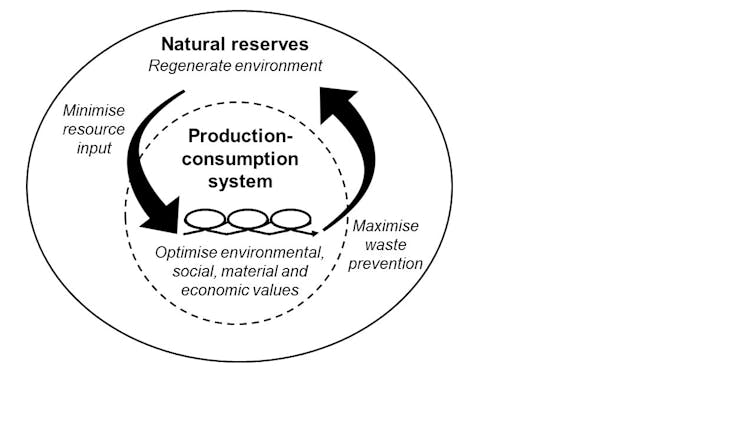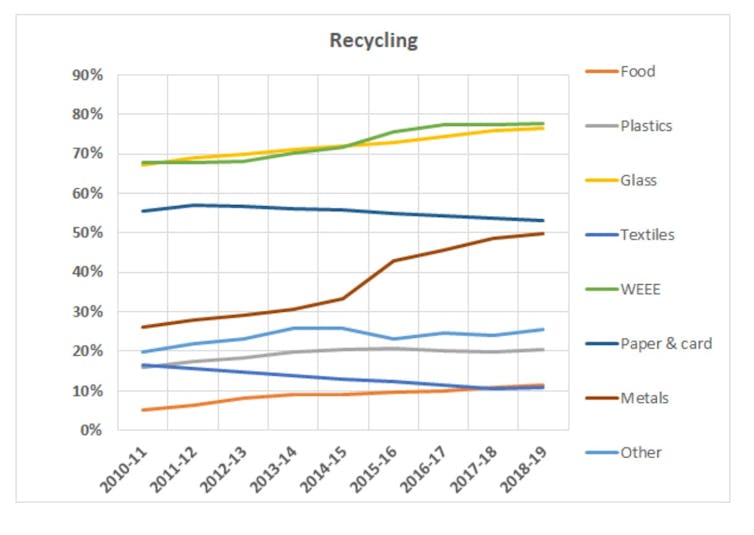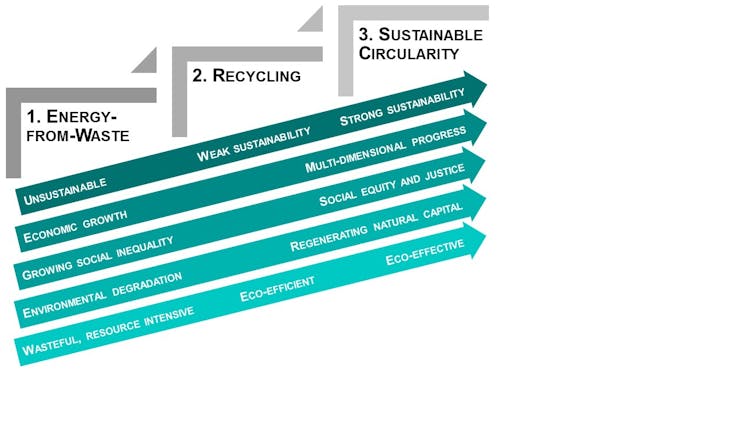What a sustainable circular economy would look like

Anne Velenturf, University of Leeds and Phil Purnell, University of Leeds
More than 100 billion tonnes of materials entered the global economy in 2017 to generate power, build infrastructure and homes, produce food, and provide consumer goods such as clothes and phones. There are now more phones than people on the planet, and the amount of clothes purchased is forecast to reach more than 92 million tonnes by 2030.
Some estimates suggest that 99% of the things people buy is discarded within six months of purchasing without the material being recovered. That’s because we have what you might call a linear economy. It works by extracting resources and manufacturing products from them, that are sold to people and then generally disposed of after a short period of use.
But the COVID-19 pandemic has upended normal economic activity, dipping the global economy into what may become the worst economic downturn since the Great Depression. Rather than try to revive a system that’s inherently wasteful, the European Commission has vowed to build a sustainable circular economy post-pandemic.

The idea of a circular economy is simple: to make better use of resources, close loops of resource flows by fully recovering materials instead of wasting them, and prevent waste and pollution by better design of products and materials and keeping them in use for longer.
Sounds great, but how might it work? Our research programme supported the implementation of a circular economy in the UK and we discovered that three broad types exist.
1. Closing loops with energy from waste
The first strategy to “close” loops of material flows is energy from waste (EfW) – burning discarded material to generate electricity. This has replaced landfill as the main processing method for household waste in the UK. Local authorities in the UK collect 26 million tonnes of waste per year, of which 11 million tonnes goes to EfW while three million tonnes ends up in landfill. Between three to six times more waste plastic, food and textiles go to EfW than are recycled. One and a half times more paper and card go to recycling as go to EfW.

DEFRA and WRAP/Phil Purnell, Author provided
Burning materials that could be recycled means everything invested in them is lost, such as money, energy, water and labour. Materials such as nutrients in food and fibres in textiles are then replaced by virgin resources, perpetuating the unsustainable impacts of resource extraction.
Although a recent inquiry suggests EfW may have some social benefits – like providing heat to fuel-poor households – it creates fewer jobs than recycling, reuse, repair and remanufacturing and releases greenhouse gases.
But investment in the UK favours EfW. It’s the path of least resistance, requiring hardly any changes to supply chains or how goods are consumed and disposed of. The UK is practically heading for this pseudo circular economy that is effectively unchanged from the linear take-make-waste model, fitting in with the prevailing short-term economic thinking and a singular focus on GDP growth.
2. A circular economy based on recycling
One step up from EfW is the recovery of materials – recycling. In England, the volumes of municipal waste and the proportion that is collected for recycling has remained more or less unchanged (42%) for the past ten years. Some recycling rates have gone up (eg. from 5% to 11% for food) but others have dropped (56% to 53% for paper and card).

DEFRA and WRAP/Phil Purnell, Author provided
Textiles are particularly poor. The average UK citizen buys 26.7 kg of clothing annually – the most in Europe – and one million tonnes are discarded each year in England. Most binned clothes are incinerated, and increasingly less are recycled (from 17% to 11% since 2010). The recovered fibres are normally suitable only for lower-value applications, such as carpets and insulation. New clothes rarely contain more than a few percent of recycled material, sustaining demand for virgin natural resources.
In a circular economy that relies on recycling to close loops, people aren’t forced to change how much stuff they buy, but manufacturers and waste management companies would change more radically. For example, drinks bottles often use different plastics for the body, cap and label. If these mix in the recycling process they reduce the quality of the recycled material, but separating them is awkward. All products should be redesigned to ensure they are recyclable.
Manufacturers should use more recycled material in new products too, creating markets for recovered materials. Massive investment in recycling infrastructure would be required though. Just to meet plastic packaging recycling targets, more than 50 new recycling plants would be needed in England.
Although recycling normally is less energy-intensive than processing virgin resources, it still uses a lot of energy which produces carbon emissions. Even if all recycling used renewable energy, the new infrastructure would require vast amounts of virgin materials to be built. In developed countries the total amount of materials within the economy has to be reduced.
3. A sustainable circular economy
To achieve a truly sustainable circular economy, consumption and production practices would need to change together. A sustainable circular economy involves designing and promoting products that last and that can be reused, repaired and remanufactured. This retains the functional value of products, rather than just recovering the energy or materials they contain and continuously making products anew.
We have to do more with less material and consume responsibly. For example, people in the UK should buy fewer new clothes and wear what they already have more often. Repairing and restyling our favourite clothes can also help to use them more and waste less.
New ways of consuming opens up opportunities for circular economy business models, such as leasing clothes and producing things that people need on demand only. Business models based on reuse, leasing, repair and remanufacturing could generate four times more jobs than waste treatment, disposal and recycling. They generate local economic activity, helping to strengthen relations within communities.

A sustainable circular economy represents a new economic model in which the aim shifts from narrow GDP growth to “multi-dimensional progress” – the broader strengthening of environmental quality, human well-being and economic prosperity for current and future generations. Only such a circular economy could potentially regenerate the environment.
How we use resources has transformed our economy and society in the past. A circular economy offers us a chance to deliver sustainable benefits for the future. Let’s not waste it.
Anne Velenturf, Research Impact Fellow in Circular Economy, University of Leeds and Phil Purnell, Professor of Materials and Structures, University of Leeds
This article is republished from The Conversation under a Creative Commons license. Read the original article.
Autor*innen:
Anne Velenturf







Wir – als Projektteam – gehen mit den Autor*innen d’accord, dass wir dringend wegmüssen von einer linearen hin zu einer kreislauforientierten Wirtschaft. Recycling und ein nachhaltiges Produktdesign sind hierbei wichtige Schritte. Aber in unseren Augen kann Recycling alleine nicht dazu beitragen, eine wirklich nachhaltige Kreislaufwirtschaft zu erreichen. Entsprechend der Abfallhierarchie muss Suffizienz und damit die Vermeidung von Abfällen die bedeutendste Rolle einnehmen. Dies heißt auch, dass wir nicht nur Produkte produzieren, die langlebiger, reparierbarer und recyclebarer sind – was ohne Frage wichtig ist – sondern auch, dass wir weniger produzieren und konsumieren.